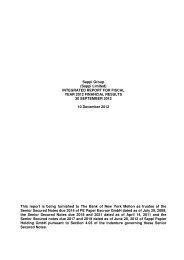2007 Annual Report - Sappi
2007 Annual Report - Sappi
2007 Annual Report - Sappi
Create successful ePaper yourself
Turn your PDF publications into a flip-book with our unique Google optimized e-Paper software.
the year that are declared after the balance sheet date are<br />
disclosed in the dividends note. Taxation costs incurred on<br />
dividends are recognised in the period in which the dividend<br />
is declared.<br />
2.3.18 Taxation<br />
Taxation on the profit or loss for the year comprises current and<br />
deferred taxation. Taxation is recognised in profit or loss except<br />
to the extent that it relates to items recognised directly to equity,<br />
in which case it is recognised in equity.<br />
(i) Current taxation<br />
Current taxation is the expected taxation payable on the taxable<br />
income, which is based on the results for the period after taking<br />
into account the necessary adjustments, for the year, using<br />
taxation rates enacted or substantively enacted at the balance<br />
sheet date, and any adjustment to taxation payable in respect<br />
of previous years.<br />
Secondary Tax on Companies (STC) is a South African Income<br />
Tax, that arises from the distribution of dividends and is<br />
recognised at the same time as the liability to pay the<br />
related dividend.<br />
(ii) Deferred taxation<br />
Deferred taxation is provided using the balance sheet liability<br />
method, based on temporary differences. Temporary differences<br />
are differences between the carrying amounts of assets and<br />
liabilities for financial reporting purposes and their taxation base.<br />
The amount of deferred taxation provided is based on the<br />
expected manner of realisation or settlement of the carrying<br />
amount of assets and liabilities using taxation rates enacted or<br />
substantively enacted at the balance sheet date. Deferred<br />
taxation is charged to profit or loss for the period, except to the<br />
extent that it relates to a transaction that is recognised directly<br />
in equity, or a business combination that is an acquisition. The<br />
effect on deferred taxation of any changes in taxation rates is<br />
recognised in profit or loss, except to the extent that it relates<br />
to items previously charged or credited directly to equity.<br />
A deferred taxation asset is recognised to the extent that it is<br />
probable that future taxable income will be available against<br />
which the unutilised taxation losses and deductible temporary<br />
differences can be used. The carrying amount of deferred tax<br />
assets is reviewed at each balance sheet date and is reduced<br />
to the extent that it is no longer probable that sufficient taxable<br />
profits will be available to allow all or part of the asset to<br />
be recovered.<br />
2.3.19 Borrowing costs<br />
Borrowing costs directly attributable to the acquisition,<br />
construction and production of qualifying assets are capitalised<br />
as part of the costs of those assets.<br />
Capitalisation of borrowing costs continues up to the date when<br />
the assets are substantially ready for their use or sale.<br />
Details of borrowing costs capitalised are disclosed in the notes<br />
to the accounts by asset category and are calculated at the<br />
group’s average funding cost, except to the extent that funds<br />
are borrowed specifically for the purpose of obtaining a<br />
qualifying asset. Where this occurs, actual borrowing costs<br />
incurred less any investment income on the temporary<br />
investment of those borrowings are capitalised.<br />
2.3.20 Cost of sales<br />
When inventories are sold, the carrying amount is recognised as<br />
part of cost of sales. Any write-down of inventories to net<br />
realisable value and all losses of inventories or reversals of<br />
previous write-downs or losses are recognised in cost of sales<br />
in the period the write-down, loss or reversal occurs.<br />
2.3.21 Revenue<br />
Revenue represents the gross inflow of economic benefits<br />
during the period arising in the course of the ordinary activities<br />
when those inflows result in increases in equity, other than<br />
increases relating to contributions from equity participants.<br />
Revenue from the sale of goods (sales) is recognised when the<br />
significant risks and rewards of ownership have been transferred,<br />
when delivery has been made and title has passed, when the<br />
amount of the revenue and the related costs can be reliably<br />
measured and when it is probable that the debtor will pay for<br />
the goods. For the majority of local and regional sales, transfer<br />
occurs at the point of offloading the shipment into the customer<br />
warehouse, whereas for the majority of export sales transfer<br />
occurs when the goods have been loaded into the relevant<br />
carrier, unless the contract of sales specifies different terms.<br />
Revenue is measured at the fair value of the amount received<br />
or receivable. Trade and settlement discounts, rebates, and<br />
customer returns given are included in sales.<br />
Shipping and handling costs, such as freight to our customers’<br />
destination are included in cost of sales, in the consolidated<br />
income statement. These costs, when included in the sales<br />
price charged for our products are recognised in net sales.<br />
sappi limited | 07 | annual report 85
















